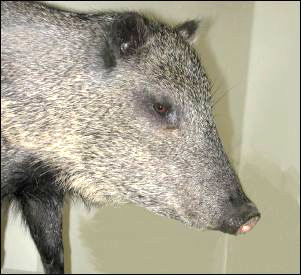

Global warming is big in the news, though argument continues as to the role of man. Nature often picks up on trends before we do. One way we see this is in changes in the ranges of animals and plants. Unfortunately, with the relatively low levels of funding for environmental research, we often are ignorant of the controlling factors in such changes in geographic distribution.
The Javelina, or Collared Peccary, is one animal who has been advancing northward in recent years in the central, northern Chihuahuan Desert. Formerly in the rough lands along the Rio Grande well southeast of El Paso, it has been moving northward along the edges of the Hueco and Tularosa basins. Photographic evidence places it east of Orogrande, and reports have it as far north as Alamogordo.
Evidence of warming? Probably. However, Collared Peccaries are relative
newcomers to the Southwest, with no fossil record in the northern Chihuahuan Desert and
with no remains recorded from archaeological sites. Just possibly, this is another
pulse of its invasion of the north.

Contributor: Arthur H. Harris, Laboratory for Environmental Biology, Centennial Museum, University of Texas at El Paso.
Desert Diary is a joint production of the Centennial Museum and KTEP National Public Radio at the University of Texas at El Paso.

Javelina mount: Centennial Museum exhibit. Photograph by A.H. Harris.
University of Michigan Museum of Zoology. Basic data on Javelina.